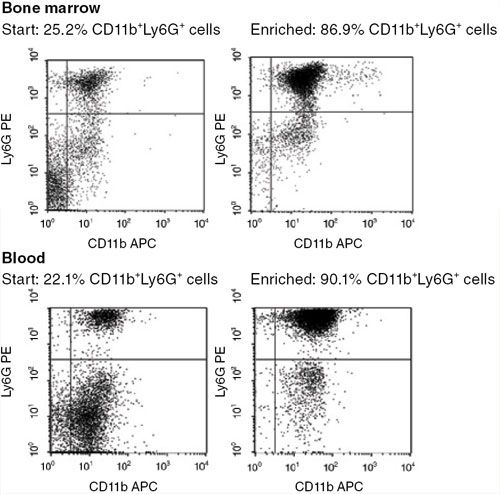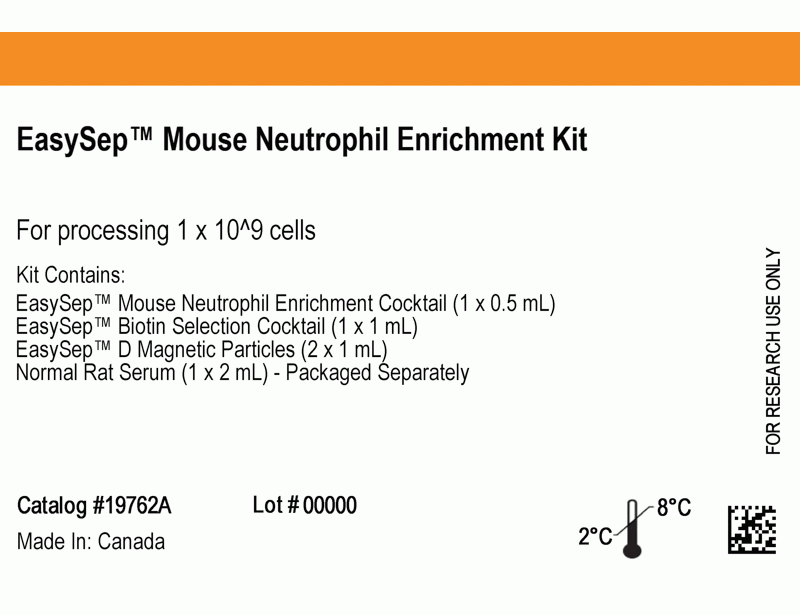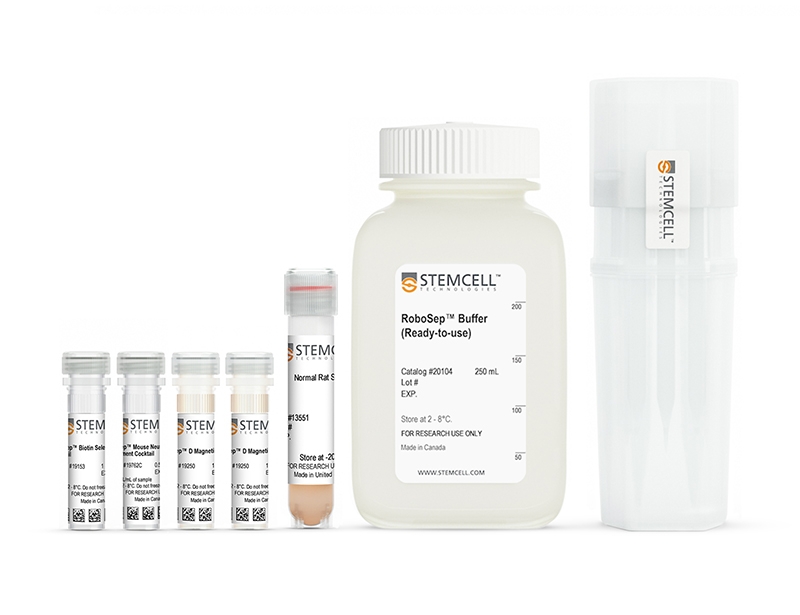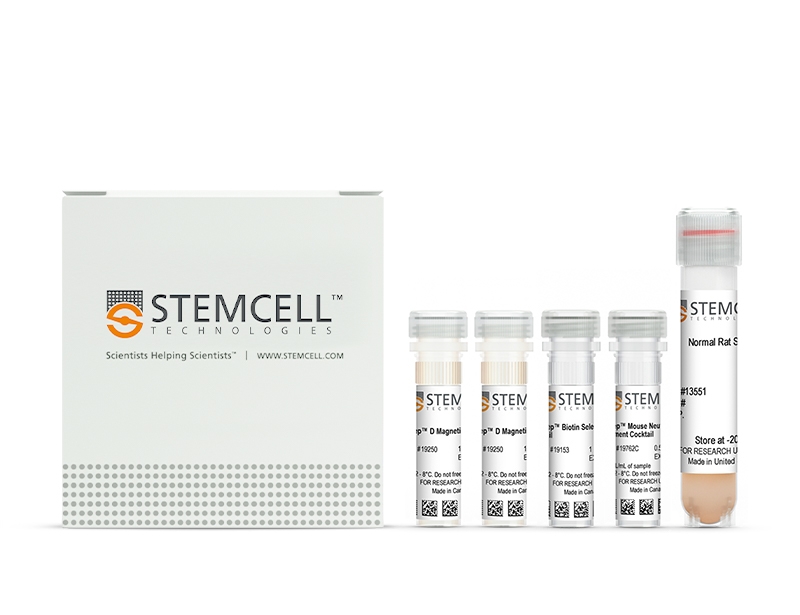EasySep™ Mouse Neutrophil Enrichment Kit
Immunomagnetic negative selection cell isolation kit
概要
The EasySep™ Mouse Neutrophil Enrichment Kit is designed to isolate neutrophils from single-cell suspensions of bone marrow or other tissues by negative selection. Unwanted cells are targeted for removal with biotinylated antibodies that are directed against non-neutrophils. Labeled cells are then recognized by Tetrameric Antibody Complexes that are directed against biotin and dextran. These cells are bound to magnetic particles and separated using an EasySep™ magnet without the use of columns. Desired cells are poured off into a new tube.
Advantages
• Fast, easy-to-use and column-free
• Up to 93.7% (blood) and 88.7% (bone marrow) purity
• Isolated cells are untouched
• Up to 93.7% (blood) and 88.7% (bone marrow) purity
• Isolated cells are untouched
Components
- EasySep™ Mouse Neutrophil Enrichment Kit (Catalog #19762)
- EasySep™ Mouse Neutrophil Enrichment Cocktail, 0.5 mL
- EasySep™ Biotin Selection Cocktail, 1 mL
- EasySep™ Magnetic Particles, 2 x 1 mL
- Normal Rat Serum, 2 mL
- RoboSep™ Mouse Neutrophil Enrichment Kit with Filter Tips (Catalog #19762RF)
- EasySep™ Mouse Neutrophil Enrichment Cocktail, 0.5 mL
- EasySep™ Biotin Selection Cocktail, 1 mL
- EasySep™ Magnetic Particles, 2 x 1 mL
- Normal Rat Serum, 2 mL
- RoboSep™ Buffer (Catalog #20104)
- RoboSep™ Filter Tips (Catalog #20125)
Magnet Compatibility
• EasySep™ Magnet (Catalog #18000)
• “The Big Easy” EasySep™ Magnet (Catalog #18001)
• RoboSep™-S (Catalog #21000)
Subtype
Cell Isolation Kits
Cell Type
Granulocytes and Subsets
Species
Mouse
Sample Source
Bone Marrow, Whole Blood
Selection Method
Negative
Application
Cell Isolation
Brand
EasySep, RoboSep
Area of Interest
Immunology
技术资料
| Document Type | 产品名称 | Catalog # | Lot # | 语言 |
|---|---|---|---|---|
| Product Information Sheet | EasySep™ Mouse Neutrophil Enrichment Kit | 19762 | All | English |
| Product Information Sheet | RoboSep™ Mouse Neutrophil Enrichment Kit with Filter Tips | 19762RF | All | English |
| Safety Data Sheet 1 | EasySep™ Mouse Neutrophil Enrichment Kit | 19762 | All | English |
| Safety Data Sheet 2 | EasySep™ Mouse Neutrophil Enrichment Kit | 19762 | All | English |
| Safety Data Sheet 1 | RoboSep™ Mouse Neutrophil Enrichment Kit with Filter Tips | 19762RF | All | English |
| Safety Data Sheet 2 | RoboSep™ Mouse Neutrophil Enrichment Kit with Filter Tips | 19762RF | All | English |
数据及文献
Data

Figure 1. Typical FACS Profiles for EasySep™ Mouse Neutrophil Kit
The CD11b+Ly6G+ cell content of the enriched cells typically ranges from 69.9% - 88.7% with bone marrow samples, and 80.1% - 93.7% with blood samples.
Publications (19)
Cell metabolism 2020 mar
Macrophage Metabolism of Apoptotic Cell-Derived Arginine Promotes Continual Efferocytosis and Resolution of Injury.
Abstract
Abstract
Continual efferocytic clearance of apoptotic cells (ACs) by macrophages prevents necrosis and promotes injury resolution. How continual efferocytosis is promoted is not clear. Here, we show that the process is optimized by linking the metabolism of engulfed cargo from initial efferocytic events to subsequent rounds. We found that continual efferocytosis is enhanced by the metabolism of AC-derived arginine and ornithine to putrescine by macrophage arginase 1 (Arg1) and ornithine decarboxylase (ODC). Putrescine augments HuR-mediated stabilization of the mRNA encoding the GTP-exchange factor Dbl, which activates actin-regulating Rac1 to facilitate subsequent rounds of AC internalization. Inhibition of any step along this pathway after first-AC uptake suppresses second-AC internalization, whereas putrescine addition rescues this defect. Mice lacking myeloid Arg1 or ODC have defects in efferocytosis in vivo and in atherosclerosis regression, while treatment with putrescine promotes atherosclerosis resolution. Thus, macrophage metabolism of AC-derived metabolites allows for optimal continual efferocytosis and resolution of injury.
Blood 2020 jan
NADPH oxidase controls pulmonary neutrophil infiltration in the response to fungal cell walls by limiting LTB4.
Abstract
Abstract
Leukocyte nicotinamide adenine dinucleotide phosphate (NADPH) oxidase plays a key role in host defense and immune regulation. Genetic defects in NADPH oxidase result in chronic granulomatous disease (CGD), characterized by recurrent bacterial and fungal infections and aberrant inflammation. Key drivers of hyper-inflammation induced by fungal cell walls in CGD are still incompletely defined. Here, we found that CGD (CYBB-null) neutrophils produced higher amounts of leukotriene B4 (LTB4) in vitro following activation with zymosan or Immune complexes, as compared to wild type (WT) neutrophils. This correlated with increased calcium influx in CGD neutrophils, which is restrained in WT neutrophils by the electrogenic activity of the NADPH oxidase. Increased LTB4 generation by CGD neutrophils was also augmented by paracrine cross-talk with the LTB4 receptor BLT1. CGD neutrophils formed more numerous and larger clusters in the presence of zymosan in vitro compared to WT, which was also LTB4- and BLT1-dependent. In zymosan-induced lung inflammation, focal neutrophil infiltrates were increased in CGD compared to WT mice and associated with higher LTB4 levels. Inhibiting LTB4 synthesis or antagonizing the BLT1 receptor following zymosan challenge reduced lung neutrophil recruitment in CGD to WT levels. Thus, LTB4 was the major driver of excessive neutrophilic lung inflammation in CGD mice in the early response to fungal cell walls, likely by a dysregulated feed-forward loop involving amplified neutrophil production of LTB4. This study identifies neutrophil LTB4 generation as a target of NADPH oxidase regulation, which could potentially be exploited therapeutically to reduce excessive inflammation in CGD.
European journal of applied physiology 2020 jan
Acute hyperketonaemia alters T-cell-related cytokine gene expression within stimulated peripheral blood mononuclear cells following prolonged exercise.
Abstract
Abstract
PURPOSE We investigated the effect of the racemic $\beta$-hydroxybutyrate precursor, R,S-1,3-butanediol (BD), on T-cell-related cytokine gene expression within stimulated peripheral blood mononuclear cells (PBMC) following prolonged, strenuous exercise. METHODS A repeated-measures, randomised, crossover study was conducted in nine healthy, trained male cyclists (age, 26.7 ± 5.2 years; VO2peak, 63.9 ± 2.5 mL kg-1 min-1). Participants ingested 0.35 g kg-1 of BD or placebo 30 min before and 60 min during 85 min of steady-state (SS) exercise, which preceded a {\~{}} 30 min time-trial (TT) (7 kJ kg-1). Blood samples were collected at pre-supplement, pre-exercise, post-SS, post-TT and 1-h post-TT. Whole blood cultures were stimulated with Staphylococcal enterotoxin B (SEB) for 24 h to determine T-cell-related interleukin (IL)-4, IL-10 and interferon (IFN)-$\gamma$ mRNA expression within isolated PBMCs in vitro. RESULTS Serum cortisol, total circulating leukocyte and lymphocyte, and T-cell subset concentrations were similar between trials during exercise and recovery (all p {\textgreater} 0.05). BD ingestion increased T-cell-related IFN-$\gamma$ mRNA expression compared with placebo throughout exercise and recovery (p = 0.011); however, IL-4 and IL-10 mRNA expression and the IFN-$\gamma$/IL-4 mRNA expression ratio were unaltered (all p {\textgreater} 0.05). CONCLUSION Acute hyperketonaemia appears to transiently amplify the initiation of the pro-inflammatory T-cell-related IFN-$\gamma$ response to an immune challenge in vitro during and following prolonged, strenuous exercise; suggesting enhanced type-1 T-cell immunity at the gene level.
Frontiers in immunology 2020
Neutrophil L-Plastin Controls Ocular Paucibacteriality and Susceptibility to Keratitis.
Abstract
Abstract
Why ocular mucosa is paucibacterial is unknown. Many different mechanisms have been suggested but the comprehensive experimental studies are sparse. We found that a deficiency in L-plastin (LCP1), an actin bundling protein, resulted in an ocular commensal overgrowth, characterized with increased presence of conjunctival Streptococcal spp. The commensal overgrowth correlated with susceptibility to P. aeruginosa-induced keratitis. L-plastin knock-out (KO) mice displayed elevated bacterial burden in the P. aeruginosa-infected corneas, altered inflammatory responses, and compromised bactericidal activity. Mice with ablation of LPL under the LysM Cre (LysM. Cre pos LPLfl/fl ) and S100A8 Cre (S100A8.Cre pos LPLfl/fl ) promoters had a similar phenotype to the LPL KOs mice. In contrast, infected CD11c.Cre pos LPLfl/fl mice did not display elevated susceptibility to infection, implicating the myeloid L-plastin-sufficient cells (e.g., macrophages and neutrophils) in maintaining ocular homeostasis. Mechanistically, the elevated commensal burden and the susceptibility to infection were linked to defects in neutrophil frequencies at steady state and during infection and compromised bactericidal activities upon priming. Macrophage exposure to commensal organisms primed neutrophil responses to P. aeruginosa, augmenting PMN bactericidal capacity in an L-plastin dependent manner. Cumulatively, our data highlight the importance of neutrophils in controlling ocular paucibacteriality, reveal molecular and cellular events involved in the process, and suggest a link between commensal exposure and resistance to infection.
Molecular therapy : the journal of the American Society of Gene Therapy 2019 nov
Genetically Engineered Cell-Derived Nanoparticles for Targeted Breast Cancer Immunotherapy.
Abstract
Abstract
Exosomes are nanosized membranous vesicles secreted by a variety of cells. Due to their unique and pharmacologically important properties, cell-derived exosome nanoparticles have drawn significant interest for drug development. By genetically modifying exosomes with two distinct types of surface-displayed monoclonal antibodies, we have developed an exosome platform termed synthetic multivalent antibodies retargeted exosome (SMART-Exo) for controlling cellular immunity. Here, we apply this approach to human epidermal growth factor receptor 2 (HER2)-expressing breast cancer by engineering exosomes through genetic display of both anti-human CD3 and anti-human HER2 antibodies, resulting in SMART-Exos dually targeting T cell CD3 and breast cancer-associated HER2 receptors. By redirecting and activating cytotoxic T cells toward attacking HER2-expressing breast cancer cells, the designed SMART-Exos exhibited highly potent and specific anti-tumor activity both in vitro and in vivo. This work demonstrates preclinical feasibility of utilizing endogenous exosomes for targeted breast cancer immunotherapy and the SMART-Exos as a broadly applicable platform technology for the development of next-generation immuno-nanomedicines.
Nature immunology 2019 feb
A noncanonical role for the engulfment gene ELMO1 in neutrophils that promotes inflammatory arthritis.
Abstract
Abstract
Rheumatoid arthritis is characterized by progressive joint inflammation and affects {\~{}}1{\%} of the human population. We noted single-nucleotide polymorphisms (SNPs) in the apoptotic cell-engulfment genes ELMO1, DOCK2, and RAC1 linked to rheumatoid arthritis. As ELMO1 promotes cytoskeletal reorganization during engulfment, we hypothesized that ELMO1 loss would worsen inflammatory arthritis. Surprisingly, Elmo1-deficient mice showed reduced joint inflammation in acute and chronic arthritis models. Genetic and cell-biology studies revealed that ELMO1 associates with receptors linked to neutrophil function in arthritis and regulates activation and early neutrophil recruitment to the joints, without general inhibition of inflammatory responses. Further, neutrophils from the peripheral blood of human donors that carry the SNP in ELMO1 associated with arthritis display increased migratory capacity, whereas ELMO1 knockdown reduces human neutrophil migration to chemokines linked to arthritis. These data identify 'noncanonical' roles for ELMO1 as an important cytoplasmic regulator of specific neutrophil receptors and promoter of arthritis.



